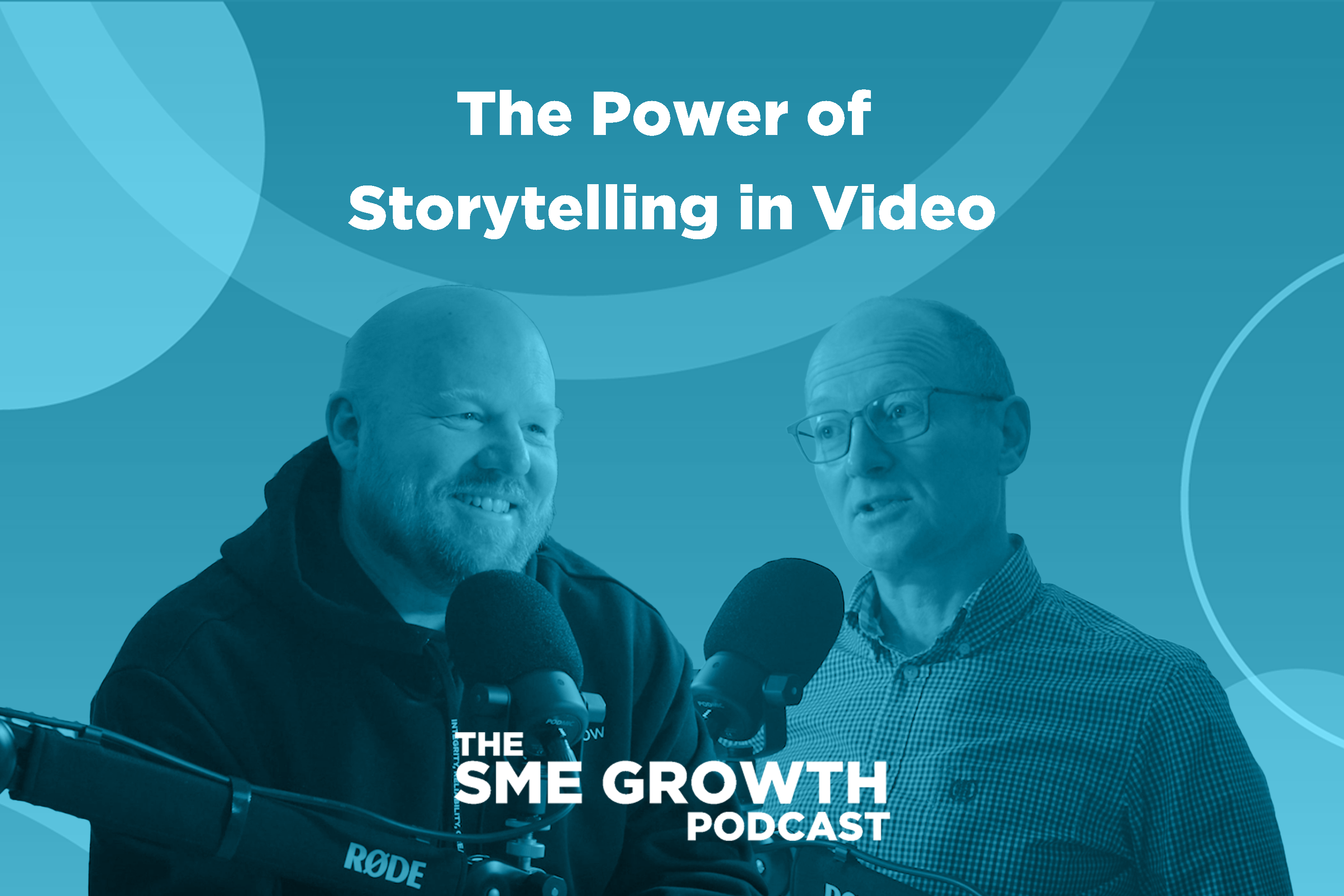Episode 42: The Manufacturing Marketing Maze
In the ever-evolving landscape of small and medium-sized enterprises (SMEs), marketing is a formidable challenge, particularly for those in the...
Wellmeadow supports ambitious companies with business growth enabled by HubSpot.
We've worked with over 100+ businesses at board-level across sectors such as automotive, manufacturing, healthcare, legal, SaaS, and professional services.

%20(A4).png?width=71&height=100&name=portrait%206-box%20model%20diagram%20(1170%20x%207051%20px)%20(A4).png)

-1.png?width=70&height=70&name=Square%20(1)-1.png)
5 min read
Hannah Hambleton : Oct 19, 2023 2:37:39 PM

With $14 billion dollars spent annually on exhibitions globally, they can be a powerful addition to a company's marketing strategy. But how do you make sure you’re getting them right? In this episode of The SME Growth Podcast, hosts Dave Parry and Richard Buckle take a look into the world of exhibiting, and share some valuable lessons and tips from a recent exhibition Wellmeadow attended.
You can listen to the podcast episode here.
There are a number of reasons why companies exhibit at tradeshows and exhibitions; and they can be an important part of a marketing strategy. These include:
FOMO (Fear Of Missing Out): Tradeshows and exhibitions are often seen as key industry events. The fear of missing out on opportunities, whether in networking, sales or exposure makes many companies want to participate.
Face-to-Face Interactions: Exhibitions provide a unique platform for face-to-face contact. In today's digital age, personal connections can be invaluable. These events enable companies to engage with potential clients, partners, and stakeholders on a more intimate level, helping to build trust and authority.
Meeting Existing Customers: Exhibitions are a great opportunity to strengthen relationships with existing customers, as well as showcase new products or services in person.
Community Building:: Exhibitions provide the opportunity to build a sense of community among industry peers, often through informal (but valuable) interactions. Companies can exchange ideas, best practices, and collaborate on common challenges, potentially leading to valuable partnerships.
Local Business Support: Participating in local business exhibitions demonstrates a commitment to supporting the local community. It's an opportunity to engage with local customers and strengthen ties with other businesses in the area.
Internal Development: A surprising benefit is that exhibitions often act as a tangible, internal deadline. This can be a powerful push for companies to expedite their new product development and refine their messaging.
Increased Brand Awareness: The exposure gained by attending exhibitions can boost brand recognition and visibility; attracting new clients and expanding market reach.
In the podcast episode, Dave Parry and Richard Buckle discuss our recent attendance at a local Shropshire Chamber Business expo. There were a number of reasons for attending, including the desire to support the local business community, to raise awareness of Wellmeadow’s marketing and business consultancy services, and also to learn more internally about the best practices when exhibiting.
Some of the learning points discussed in the episode include:
One of the key aims of the exhibition was an internal R&D test, allowing us to be more adventurous in our exhibition approach and try new things, all while still meeting a deadline and winning more clients.
One of the key aims of attending an exhibition is to boost brand awareness. This was a goal for Wellmeadow too, but attending the exhibition also allowed us to clarify our offer and brand positioning to a wider audience. We found it sometimes challenging to communicate their business' three main areas of support (board support, technical support, and marketing content creation) in a clear, quick and concise manner; and this highlighted the importance of having one clear message for future marketing activity, making it extremely worthwhile.
The need to have clarity in brand positioning was also emphasised in the importance of maintaining consistent messaging from the exhibition to the subsequent digital follow-up. As discussed in the podcast, the process prompted critical internal questions about the market, products, and how to engage effectively. Transitioning from in-person interactions to digital nurturing posed a challenge, leading to the exploration of HubSpot integration as a solution.
Through this experience, we recognised the need to align our messaging, promotion, and follow-up strategies. The exhibition served as an experimental platform, sparking discussions about our core business focus and identifying the most compelling hook – HubSpot. This strategic shift allowed us to structure our exhibition stand around HubSpot, giving us a key competitive edge.
The exhibition experience emphasised the importance of effective stand design, highlighting the following:
Clear Messaging: A clear and concise message is essential for the stand, ensuring it's easily understandable to the audience.
Think About Visual Impact: Showcasing a three-meter blow-up of our growth generator model on a double-sided stand shad a significant visual impact, providing a valuable tool for explaining our processes. We also used a 55-inch TV to highlight key, customisable messages. Visual impact is vital to stand out in an often crowded exhibitor space, working to drive as many people through the ‘attract’ stage as possible.
Use Interactive Engagement: Interactivity makes more people want to engage with your brand. Clever, interactive design can explore innovative ways to engage with visitors, such as using post-it notes for pinpointing challenges. This worked really well for Wellmeadow, and is a tactic we will use again.
Many stands have giveaways such as pens, doughnuts, keyrings and caps. At the exhibition, we introduced a unique giveaway featuring NFC tags (Near Field Communication). These tags work like advanced QR codes, but they require a simple tap on a phone to initiate an action. We aimed to make NFC tags relatable by likening them to contactless payments, without involving any financial transactions. People could customise the action when tapping the tag, such as directing it to a PayPal account or other activities. We branded these tags and encouraged attendees to explore digital activities, offering flexibility in their choices.
We provided a QR code for instructions, forms, and guidance on using the NFC tags, followed by a HubSpot workflow. The NFC tags generated a lot of interest, but they sometimes overshadowed our core product in conversations, especially for those unfamiliar with our brand.
While the NFC tag giveaway showcased our commitment to innovation, it led to some confusion among those who thought we were selling NFC tags. This showed the importance of striking a better balance between intriguing giveaways and effectively conveying the brand and product message at exhibitions.
One key lesson is that you often need more time to set up the exhibition stand than initially anticipated. Once you've been through the process, subsequent exhibitions become easier to manage!
It’s also important to think about the next exhibition, and how you can maximise its value, taking any lessons learned from the previous show. For example, Wellmeadow recently sent their video specialist to a client's exhibition to capture footage for future promotions. This forward-thinking approach ensures that each show informs the next.
Finally, the podcast discussed the return on investment (ROI) for exhibitions, revealing a common challenge- measuring the true impact. Despite difficulties in proving ROI, many businesses continue to participate in exhibitions. Industry statistics suggest that ROI typically ranges from 25% to 35%, but these figures can raise questions. Does it mean a £100,000 exhibition leads to £25,000 in sales or profits, after accounting for costs?
These industry averages should be taken with a grain of salt, and each business should calculate its own ROI. The exhibition landscape varies widely, with massive shows like those at the NEC or in London skewing the averages towards the top end. Smaller exhibitions might not yield significant business for most participants.
Tracking ROI is another challenge, but companies are starting to use tools like HubSpot to gather and manage leads. With structured workflows, companies can monitor how leads progress into customers over time, helping to demystify the exhibition ROI puzzle.
In summary, exhibitions can provide substantial marketing opportunities for companies. Wellmeadow's recent exhibition experience highlighted essential lessons, from clear messaging and impactful stand design to innovative giveaways.
The transition from exhibitions to digital follow-up underscores the importance of consistent messaging. Tools like HubSpot aid lead tracking, ROI analysis and structured workflows, making exhibitions integral to a robust marketing strategy.

In the ever-evolving landscape of small and medium-sized enterprises (SMEs), marketing is a formidable challenge, particularly for those in the...

How can accounting firms elevate their marketing game? Professional services firms, including accountants offer marketers some specific challenges,...

In this episode of the SME Growth Podcast, hosts Dave Parry and Richard Buckle discuss the latest UK business news and how this impacts SMEs, share...